Children aged 0 – 5 years of age are at the greatest risk of developing health issues from elevated blood lead levels as lead is toxic to the human body. Children absorb a higher proportion of swallowed lead than adults.
Young children are at higher risk of lead absorption as they tend to put things into their mouths, including toys, dummies and their hands, picking things up off of floors which may have lead dust on them.
Statistics from the two Queensland Health Bled for Lead campaigns show that Indigenous children are at a very high risk of elevated blood lead levels, due to low socioeconomic factors.
Children absorb lead dust through ingestion into their stomach, which travels into the blood stream, so it is important to reduce the amount of lead dust your child has access to.
There are a number of exposure sources that young children are more susceptible to than adults. These include:
If your child is exposed to high levels of lead they are at risk of developing the following health issues:
The Lead Alliance recommend the following to ensure that the risk of elevated blood lead levels in your children is greatly reduced, incorporating our key message – Wet Wipe, Wash & Eat Well:
If you require further information FREE CALL the Lead Alliance on 1800 457 547.



